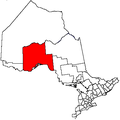Lac des Mille Lacs 22A2 | |
|---|---|
| Lac des Mille Lacs Indian Reserve No. 22A2 | |
| Coordinates: 49°01′23″N90°53′32″W / 49.02306°N 90.89222°W [1] | |
| Country | |
| Province | |
| District | Thunder Bay |
| First Nation | Lac des Mille Lacs |
| Area | |
| • Land | 31.28 km2 (12.08 sq mi) |
| Population (2011) [2] | |
• Total | 0 |
| • Density | 0/km2 (0/sq mi) |
| Website | lacdesmillelacsfirstnation |
Lac des Mille Lacs 22A2 (formerly Seine River 22A2) is a First Nations reserve in northwestern Ontario, Canada. [1] It is one of the reserves of the Lac des Mille Lacs First Nation.

